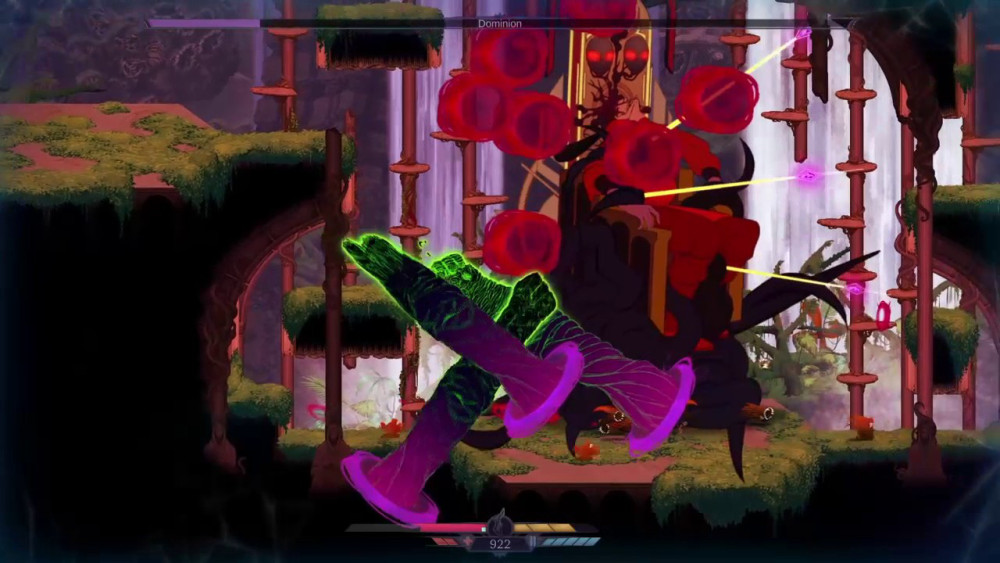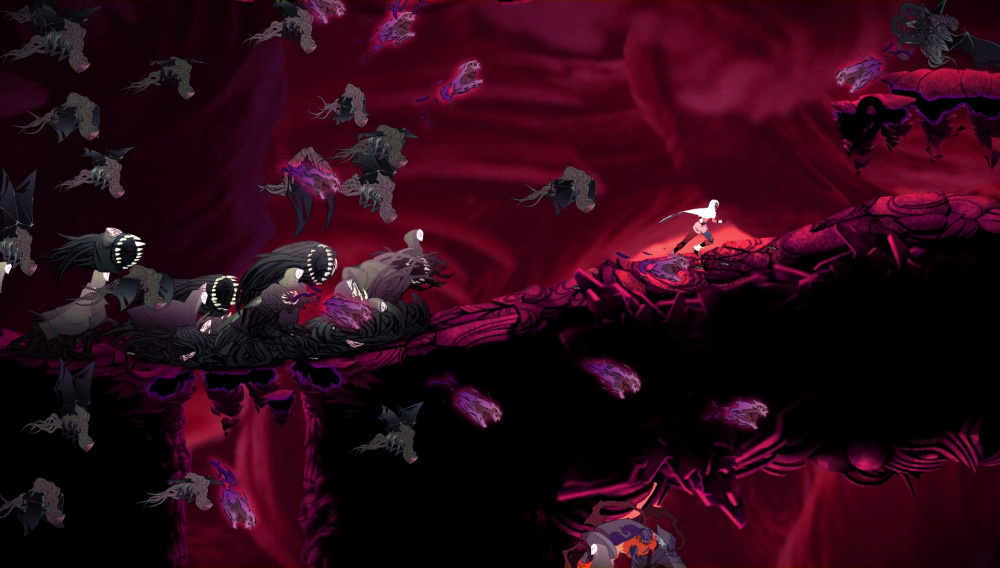Rule one of writing a critical review (no, it’s not honesty silly) is to never read anyone else’s before you’re done. There’s always a fear that their opinions will bleed into your own and end up tainting what could be an original insight into a game. The second fear is that you will be a dissenting voice in a sea of adoration, and in those instances ignorance is most certainly bliss.
Sundered peddles itself as a sort of nonlinear Metroidvania Roguelike type thing; I’d try and break that down for you if you’re confused, but so am I. And so is the game, actually – we’re all confused and no one’s happy about it. The core problem is the uninspired, repetitive gameplay that see-saws roughly every two minutes between adequate 2D platforming and straight up button mashing. Enemies, like the levels themselves, are random in a sense, but if you count down from twenty after polishing off a wave, you can probably predict when the next one’s inbound. Collision doesn’t apply to the vast majority of Sundered’s enemies, meaning that intelligently kiting and picking off your foes isn’t even an option. Having these waves of obnoxious health-sappers perpetually breathing down your neck doesn’t fill you with dread though, and that’s yet another failure I’ll get to later. No, it feels more like frustration; making any progress whatsoever means opening the map to try and make sense of the caverns, and then proceeding to overcome the same jumping puzzles over and over again to reach the next area. Of course, the map doesn’t pause the game (thank you Dark Souls) and the endless dredge of monstrosities make it their personal goal to throw you around the room like a really tiny ping pong ball. Losing sight of your character is ridiculously easy, especially during some of those boss fights, so you’re gonna be fighting the game as well as your foes.
 Find the player character. It’s okay – I’ll wait.
Find the player character. It’s okay – I’ll wait.
Sundered appears to draw on Lovecraftian themes, with ancient elders, eldritch horrors and tentacle monsters abound. The trailers featured screams of soldiers and the protagonist as the madness of their prison devoured their very sanity, so where was all this in-game? Spawning enemies on top of the player’s location could have been used to really inject some fear into the whole experience. The knowledge that you are being hunted is scary, but when there’s no risk, and when enemies are mainly just an inconvenience, the process becomes exhausting. When I die, I expect at the very least a slap on the wrist, or the partial extraction of my mortal soul – Sundered lets me restart with all my money, for Christ sake!
Even as a piece of art, the game has it’s ups and downs. Possibly the greatest achievement here is that of the animation. Sundered’s smooth, hand-drawn visuals really manage to inspire awe if you have the time to stop and take it all in (spoilers – you don’t). The player and enemies are also afforded a very crisp appearance, and the way each animation transitions into the next is both unnatural and hypnotic. The praise stops there: as much as I do love these visuals, having fifteen or so of the same sprite dogpile me not only makes it difficult to appreciate the skill that went into creating it, but conjures the sense that I have already seen what this creature has to offer a hundred times before. Likewise the soundtrack, although very good at generating atmosphere, lacks any distinguishing features and is mostly forgettable.
 Sir! I just want a moment of your time to talk about Cthulhu!
Sir! I just want a moment of your time to talk about Cthulhu!
I need to address these damn levels: the world appears to be split into three regions, each with their own basic layout, ability shrines, bosses, et cetera. Now, that’s all well and good, it’s Metroidvania, and Metroidvanias are fun. What Sundered chose to do, however, is inject it with a healthy dose of Rogue, as is the modern indie developer’s way. The caverns rework themselves upon every death (explaining, but not justifying the tedious load times), meaning limitless potential for exploration. At least, in theory; anyone who’s really fell in love with a procedurally generated game knows that after a while, patterns begin to emerge, rooms begin to look the same and you quickly realise you’re walking a labyrinth and not a maze. It means less development time and less intelligent design – heck, when it came to enemy placement, Sundered just screamed NO. It’s a real shame, because the tutorial had me thinking that perhaps I’d be navigating devious puzzles and outsmarting enemies.
Maybe I’m being too harsh, but Sundered doesn’t attempt to offer anything new, and hints at a great deal more than it delivers upon. Thematically, it’s a failure, and I groan every time I die not because of lost progress, but because it means more play time. The whole Harry Potter maze deal is kinda clichéd at this point, and sure I get the desire to pad out a game to give your audience more to do, but what ever happened to the sheer quality that handmade levels provide? You can still find that – Hollow Knight wouldn’t be a bad place to start; it’s a damn better performance than this.
And about those glowing reviews? Yeah, I don’t understand them either; maybe there’s a different Sundered I should have bought.
– Originally written for the University of Kent’s InQuire
Advertisements Share this:





